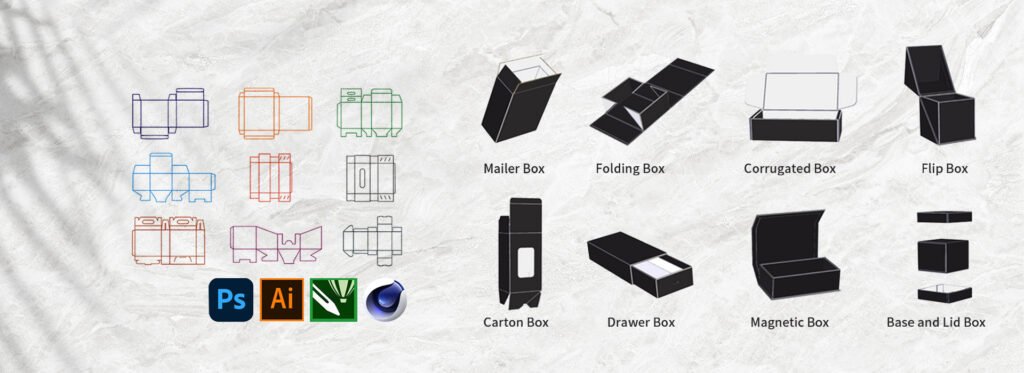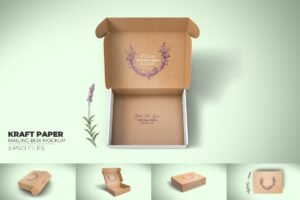Packaging covers far more than simply protecting a product. it is a silent salesman and a crucial factor in determining the success of your offering. Let’s delve into the various aspects that need to be considered when choosing the ideal packaging for your products.
Depending on your target audience, your packaging could be a plain, minimalistic cardboard box or something with a vibrant design and print.
I. Introduction
The importance of packaging for products cannot be overstated. It serves multiple functions, acting as the first point of contact between the consumer and the item. Good packaging protects the product from damage during transportation and storage, maintains its quality and freshness, and provides essential information about the contents. Moreover, it plays a significant role in attracting customers, influencing their purchasing decisions, and creating a memorable brand experience.
When it comes to choosing packaging, several factors need to be taken into account. These include the nature of the product, the brand image, cost considerations, environmental impact, and regulatory requirements.
II. Understanding Your Product
The characteristics of the product are fundamental in determining the appropriate packaging. The size and shape of the item dictate the dimensions and form of the packaging. A bulky product might require a larger box with adequate padding, while a small, delicate item could need a custom-fit container to prevent movement and breakage. The fragility of the product is another critical aspect. Fragile items like glassware or electronics need shock-absorbing materials and secure closures to ensure they reach the customer in perfect condition.
The function and purpose of the product also influence the packaging choice. For example, if it’s a food product, the packaging must preserve its taste, texture, and nutritional value. If it’s a medical device, the packaging needs to maintain sterility and provide clear instructions for use.
Understanding your target audience and market segment is equally important. A product aimed at children might have packaging with bright colors, cartoon characters, and easy-open features. On the other hand, a luxury product targeted at affluent adults might feature elegant, minimalist packaging made from high-quality materials.
III. Branding and Marketing Considerations
Your brand image and identity should be reflected in the packaging. The colors, fonts, and overall design should align with your brand’s personality and values. A consistent brand image across all packaging helps build brand recognition and loyalty.
Packaging is also a medium to communicate key messages to the consumers. It can highlight the product’s unique selling points, benefits, and ingredients. For instance, a skincare product might list its natural ingredients or anti-aging properties on the packaging.
A visually appealing design is a powerful tool for attracting customers. It should stand out on the shelf, catching the eye and inviting exploration. A creative and aesthetically pleasing packaging can differentiate your product from competitors and create a positive first impression.
IV. Materials and Durability
There is a wide range of packaging materials available, such as paper, plastic, glass, and metal, each with its own properties and suitability. Paper is eco-friendly and cost-effective but may not be as durable as plastic or metal for certain products. Plastic offers flexibility and lightweight options but raises environmental concerns. Glass provides a premium look but is more fragile and heavier.
The properties of each material need to be evaluated based on the requirements of the product. For instance, if moisture protection is crucial, plastic or laminated paper might be preferred. To ensure product protection and longevity, the packaging should be able to withstand handling, stacking, and varying environmental conditions.

V. Cost Implications
Budget constraints are often a reality in packaging decisions. It’s essential to strike a balance between quality and cost. While it might be tempting to opt for the cheapest option, sacrificing quality could lead to damaged products and dissatisfied customers.
Finding the right balance involves considering the value the packaging adds to the product. Sometimes, investing a little more in superior packaging can enhance the perceived value of the item and justify a higher price point.
In the long term, efficient packaging designs that minimize material waste and optimize transportation can lead to significant cost savings. For example, using stackable or collapsible packaging can reduce storage and shipping costs.
VI. Environmental Impact
With growing environmental consciousness, sustainability and eco-friendly options are becoming increasingly important. Consumers are more likely to choose products with packaging that is recyclable, biodegradable, or made from renewable resources.
Understanding consumer preferences for green packaging can give your brand a competitive edge. Brands that adopt sustainable packaging practices demonstrate their commitment to the environment and can attract environmentally conscious customers.
Meeting regulatory requirements regarding packaging waste and environmental standards is not only a legal obligation but also essential for maintaining a positive brand image.
VII. Packaging Size and Portability
The size and portability of the packaging have practical implications. It should be convenient for storage and transportation, both for your business and the distribution chain. Compact and stackable packaging can maximize warehouse space and reduce shipping costs.

From the consumer’s perspective, the packaging should be easy to handle and use. Lightweight and ergonomic designs make it more convenient for them to carry and store the product at home.
The size of the packaging also affects its display on the shelf. It should occupy an appropriate amount of space, ensuring visibility without overwhelming other products.
VIII. Regulatory and Legal Requirements
Compliance with labeling and information disclosure regulations is crucial. The packaging must provide accurate and clear information about the product, including ingredients, allergens, usage instructions, and safety warnings.
Adhering to safety standards is essential to protect the consumers and avoid legal liabilities. Different countries may have specific regulations regarding packaging, and it’s important to be aware of and comply with these to ensure smooth market entry.
IX. Testing and Prototyping
Before finalizing the packaging, conducting tests for functionality is essential. This includes drop tests, compression tests, and moisture resistance tests to ensure the packaging can withstand real-world conditions.
Gathering feedback from potential users can provide valuable insights. Their opinions on usability, aesthetics, and other aspects can help refine the packaging design.
Based on the test results and feedback, improvements can be made to create the most effective and customer-friendly packaging.
X. Conclusion
Choosing the right packaging is a complex but crucial decision that involves considering multiple factors. A strategic packaging choice can enhance the product’s appeal, protect its quality, and communicate the brand effectively.
It’s not just about the immediate impact but also the long-term implications for cost, the environment, and customer satisfaction. Keeping an eye on future trends in packaging, such as smart packaging and interactive designs, can help your brand stay ahead in the market.






